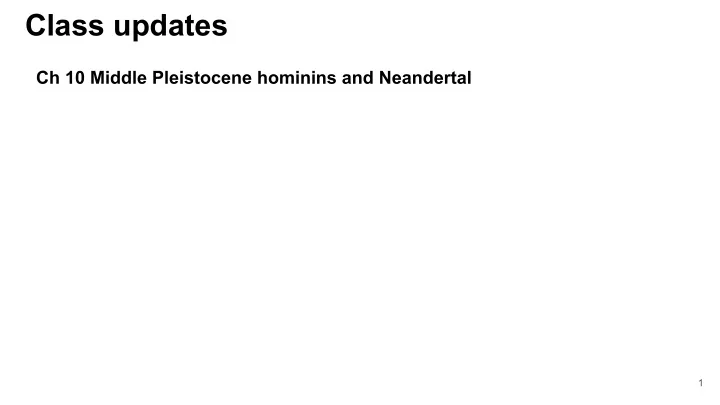

Class updates Ch 10 Middle Pleistocene hominins and Neandertal 1
2
3
4
Practice: Identify that hominin 5
Practice: Identify that hominin 6
Practice: Identify that hominin 7
Practice: Identify that hominin 8
Middle Pleistocene setting Middle Pleistocene: 780-125 kya; the "Ice Age" -numerous glacial and interglacials occurred -climatic oscillations affected Hominins in Africa, Europe, and Asia Late Pleistocene: 125-10 kya -last glaciations -Neandertal emerges in Europe 9
Middle Pleistocene setting *In Africa Interglacial periods: more rainfall Glacial periods: more arid 10
Middle Pleistocene setting *In Europe Interglacial periods: Europe accessible to migrating hominins through Eurasia Glacial periods: colder and inaccessible to migrating hominins through Eurasia 11
Middle Pleistocene hominins -Europe becomes more permanently and densely populated -Middle Pleistocene hominins remained and expanded ranges of H. erectus 12
Middle Pleistocene hominins -Europe becomes more permanently and densely populated 13
Homo heidelbergensis -ancestor to both group Homo sapiens and Neandertal -widely dispersed in Africa, Europe, and Asia 14
H. heidelbergensis Morphological characteristics -large face, projected brows, low forehead, thick cranial vault, -increased brain size, rounded braincase 15
H. heidelbergensis *In general H. heidelbergensis in Europe gave rise to Neandertal H. heidelbergensis in Africa gave rise to Homo sapiens 16
Middle Pleistocene culture -Acheulian tools used up to the Middle Pleistocene *Levallois technique -More control over flake size/shape -Suggests increased cognitive capabilities 17
Middle Pleistocene hominins sites Africa *Bodo; 600 kya; ancestral features -Earliest evidence of H. heidelbergensis Europe *Atapuerca, Spain; 500-400 kya; -80% of all Middle Pleistocene hominins remains found here -evidence of early Neandertal transition 18
Middle Pleistocene hominins and Neandertal Mousterian culture (125-40 kya) -wide-spread (Africa, Europe, Asia) -used by premodern Homo sapiens and Neandertal -more flake tools used versus core tools like bifaces 19
Middle Pleistocene hominins and Neandertal Other behaviors -lived in caves and open-air sites -temporary structures Subsistence -Diet based on more food resources: fruits, vegetables, fish, seeds, nuts, bird eggs, and: Unique: marine resources 20
Neandertal -Late Pleistocene hominin fl.130-30 kya; -European hominin most evidence for Neandertal found in Europe 21
Neandertal Neandertal morphological traits *Cranium -occipital bun -vertical forehead v H erectus , -arched rather than straight brow ridge Notable: face projects forward 22
Neandertal Neandertal morphological traits *Postcranial - robust, muscular -short limbs *Morphology = adaptations to colder climate in Europe 23
Neandertal culture and behavioral characteristics -experienced injuries while hunting -buried their dead -capable of symbolic behavior -adapted to cold climates No evidence of H. sapien -like language capabilities 24
Neandertal culture and behavioral characteristics -experienced injuries while hunting 25
Neandertal culture and behavioral characteristics -experienced injuries while hunting 26
Neandertal culture and behavioral characteristics Buried their dead -Intentional burials with individuals surrounded by tools and animal bones -capable of symbolic behavior 27
Neandertal sites Western Asia *Shanidar, Iraq; 70-60 kya -elderly, disabled man -most likely needed care to have healed wounds Europe *Krapina, Croatia; 130-110 kya -Earliest intentional burials 28
29
Recommend
More recommend